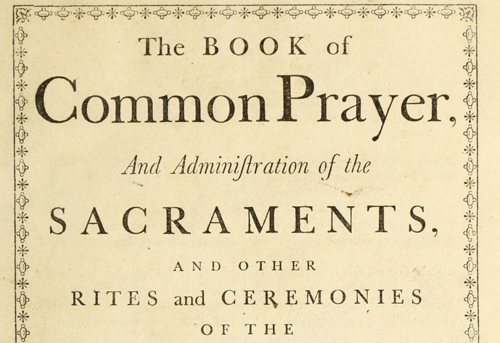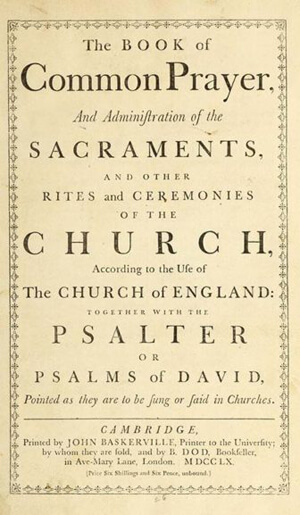
A glossary to help trainee priests understand the Church of England’s 500-year-old Book of Common Prayer has been created. CATHERINE PEPINSTER, of Religion News Service, reports…
It is the book that gave us such immortal phrases as “till death do us part” and “ashes to ashes, dust to dust”. But nearly 500 years after the creation of the Book of Common Prayer by Archbishop Thomas Cranmer, many people, even priests, find its prose not so much eminently quotable, as mystifying.
Now the Church of England’s trainee clergy are being offered help to understand Cranmer’s more obscure prose through a publication of a glossary. All first-year ordinands – the trainee priests studying at theological colleges – are to be given a copy of the guide together with a free copy of the Book of Common Prayer, an English-language product of the 16th-century break between England and the Roman Catholic Church, where Latin ruled.

A 1760 printing of the 1662 Book of Common Prayer. PICTURE: Via Wikimedia Commons.
“I’m of a generation where all ‘God speak’ is alien. The idea that Common Worship (a more contemporary Anglican prayer book) is in some way the language of the streets or contains concepts that are somehow more ‘relatable’ is just nonsense.”
– author of the glossary, Fergus Butler-Gallie.
The glossary will help students and others come to grips with phrasing such as “the quick and the dead,” which means the living and the dead and has nothing to do with being fast, and explains that “miserable”, for Cranmer, meant “pitiable” rather than feeling depressed.
The guide was written by Fergus Butler-Gallie, a 25-year-old first-year ordinand at Westcott House theological college in Cambridge, and commissioned by the Prayer Book Society, which promotes the Book of Common Prayer.
Though the Anglican Communion has since adopted prayer books in more modern language, the BCP still inspires strong feelings among many of its 80 million-plus adherents, with Prayer Book Society members passionately advocating for what they consider the unsurpassed beauty of Cranmer’s prose.
According to the recently retired bishop of London, the Rt Rev Richard Chartres, the Book of Common Prayer offers timeless qualities that can make it attractive to the younger generation.
“Far be it from me to promote a cult of quaintness, but the power of the Prayer Book to connect with many of those who find the ordinary diet of the church banal should not be ignored. There is now a younger generation who are realising afresh the importance of complementing the argot of Twitter and SMS (texting) with the majesty of Cranmer.”
Mr Butler-Gallie himself says that many people are so new to Christianity that even the more contemporary forms of worship are alien to them. But with help, Cranmer’s work is comprehensible.
“I’m of a generation where all ‘God speak’ is alien. The idea that Common Worship (a more contemporary Anglican prayer book) is in some way the language of the streets or contains concepts that are somehow more ‘relatable’ is just nonsense,” he said.
“Indeed, the BCP provides considerably more space for the uninitiated – they’re not being dragged out the front to take part in an activity that they may or may not feel comfortable partaking in or having their hands enthusiastically grasped by total strangers. The liturgy has a shape and beauty that can wash over you in a way that creates a space that is actually rather accessible as it allows you to sit in the gap created.”
The Book of Common Prayer contains morning prayer, evening prayer, the Holy Communion service and a litany, as well as services for baptism, marriage and funerals, and epistle and Gospel readings for each Sunday in the liturgical years. It was revised by Cranmer in 1552 and after a break in its use during the reign of Queen Mary, who restored Roman Catholicism in England and had Cranmer executed.
“[I]t’s the perfect ‘millennial’ liturgy in that it provides not only the roots but also the breathing space so craved by an unsure generation.”
– Mr Butler-Gallie, speaking of the Book of Common Prayer.
It was revived again during the reign of Elizabeth I. A later edition became the standard prayer book for the Church of England until the 21st century, when Common Worship became the more-often-used prayer book in Anglican Communion churches.
“In this sense it’s the perfect ‘millennial’ liturgy in that it provides not only the roots but also the breathing space so craved by an unsure generation,” Mr Butler-Gallie said of the Book of Common Prayer. “The intricacies actually come later – indeed, part of the purpose of the glossary was to encourage people to think through some of the theology behind that beautiful language.”
Mr Butler-Gallie said younger people from totally unchurched backgrounds have discerned a vocation through encounters with Prayer Book worship. He includes himself in this group.
The Book of Common Prayer was written by Cranmer when he was Archbishop of Canterbury and was first published in 1549 in the reign of Edward VI, after his father Henry VIII’s break with Rome. The glossary includes:
• Ghost; Ghostly: from Old English gāst (German, Geist) Spirit; spiritual. eg ” …together with ghostly counsel and advice.”
• Militant: the Church on earth, those still “fighting the good fight of faith” (from the Latin militans) as opposed to the Church Triumphant in Heaven. eg “Let us pray for the whole state of Christ’s Church militant here in earth.”
• Quick, quicken: living; to make alive, eg “the quick and the dead.”
• Suffer: to endure pain, to tolerate or allow, as in “Suffer the little children to come unto me.”






